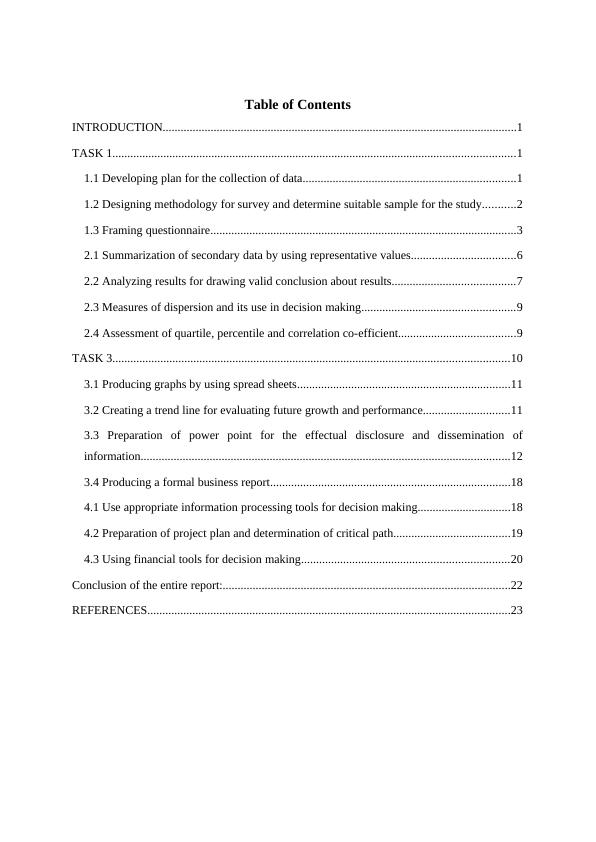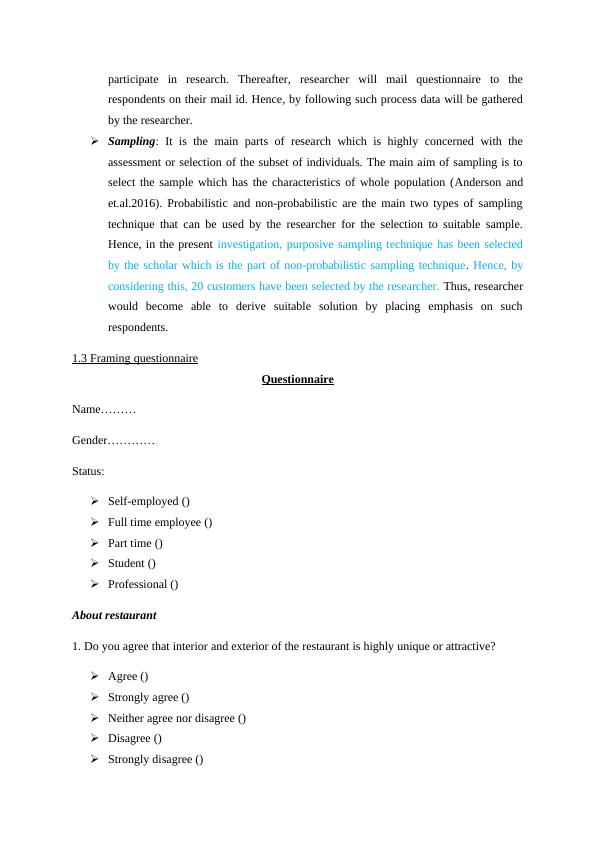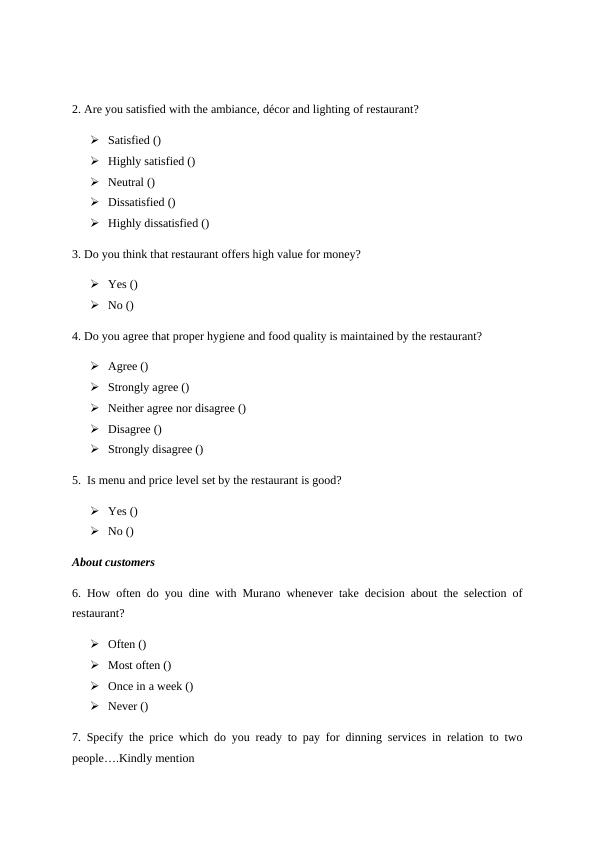Business Decision Making INTRODUCTION 1 TASK 1 1.1 Designing methodology for the collection of data
Added on 2020-01-28
25 Pages4293 Words353 Views
BusinessDecisionMaking

Table of ContentsINTRODUCTION......................................................................................................................1TASK 1......................................................................................................................................11.1 Developing plan for the collection of data.......................................................................11.2 Designing methodology for survey and determine suitable sample for the study...........21.3 Framing questionnaire......................................................................................................32.1 Summarization of secondary data by using representative values...................................62.2 Analyzing results for drawing valid conclusion about results.........................................72.3 Measures of dispersion and its use in decision making...................................................92.4 Assessment of quartile, percentile and correlation co-efficient.......................................9TASK 3....................................................................................................................................103.1 Producing graphs by using spread sheets.......................................................................113.2 Creating a trend line for evaluating future growth and performance.............................113.3 Preparation of power point for the effectual disclosure and dissemination ofinformation...........................................................................................................................123.4 Producing a formal business report................................................................................184.1 Use appropriate information processing tools for decision making...............................184.2 Preparation of project plan and determination of critical path.......................................194.3 Using financial tools for decision making.....................................................................20Conclusion of the entire report:................................................................................................22REFERENCES.........................................................................................................................23

INTRODUCTIONIn the present times, business entity has to take effectual financial and non-financialdecisions that directly aid in the growth as well as profitability aspect of firm. In this regard,manager must have ability to make proper assessment of market trend as well as needs, wantsand expectation level of the customers. Along with this, now several statistical and financialtools are available that can be used by managers for decision making. Hence, by makingappropriate decisionfirm can get the desired level of outcome or success. The present reportis based on Murano which provide customers with the amazing dining experience. In this, thepresent report will describe the manner in which researcher can gather data for conductinginvestigation. Further, report will develop understanding about the manner in whichtechniques of statistics such as mean, mode and median assists in making suitable decisionthrough summarization. Besides this, report will also provide deeper insight about howtechniques of investment appraisal assist in making selection of suitable proposal. TASK 11.1 Developing plan for the collection of dataBy considering the trend of tourism in London and growth of restaurant sectorbusiness entity of Murano has taken decision in relation to opening of restaurant. With themotive to reduce the level of risk restaurant owner is planning to conduct research which inturn helps in getting information about market and target market. Thus, by keeping suchaspects in mind scholar has undertaken both primary and secondary data methods are asfollows:Primary data collection and plan: It implies for the data which is obtained by the researcherthrough the means of observation, focus group, interview etc. (Ramnarayanan, Berenson andOppenheim, 2016). Hence, in this, researcher makes his own efforts for the collection of datain accordance with the research issue or purpose. Selection of method: In the first step, researcher selects type of method which heneeds to undertake for the collection of data. Hence, in this, researcher has takendecision to collect data through the means of survey. It is the most effectual methods

which in turn help in the collecting suitable information about the issue within thesuitable time frame. Framing questionnaire: For survey, questionnaire is the prior requirement whichscholar has to frame for the collection of data (Siegel, 2016). Hence, in the secondstage, researcher prepares questionnaire by including both close and open endedquestions. Hence, scholar will develop questionnaire by considering the main fouraspects product, price, place and promotion.Determination of sample size: At this stage, scholar will assess sample to conductsurvey in an effectual way. Thus, by using purposive sampling technique 20customers of Murano. Sending questionnaire and collection of data: Once sample has been selectedthereafter researcher will send questionnaire to the customers of Murano.Hence, by taking into consideration all the above mentioned stages researcher wouldbecome able to gather primary data. Secondary data collection and planning: Data which is readily available for the researchpurpose and decision making is known as secondary source (Jaggia and et.al. 2016).Government reports, organizational studies and outcomes, journals as well as scholarlyarticles are the most common means that can be undertaken by scholar for the collection ofsecondary data. In this, researcher will make analysis of government report to get informationabout the ratio or level of inbound and outbound tourists. This in turn also helps in assessingthe growth and customer preferences in relation to restaurant sector. Hence, researcher willalso make evaluation of the scholarly to identify the factors that havehigh level of impact oncustomer decision making. 1.2 Designing methodology for survey and determine suitable sample for the studySurvey methodology: It entails the ways through which study can be conducted by theresearcher on individuals which are selected from population. In other words, surveymethodology describes the manner through which researcher will implement the planof data collection (Chiou and Wang,2016). Hence, online survey methodology hasbeen selected by the researcher with the motive to save both time and cost.Thus, byemploying written survey methodology view points of customers will be assessed.Hence, researcher will make efforts to acquire the mail id of customers. Further,researcher will take permission from target customers as they are interest to

participate in research. Thereafter, researcher will mail questionnaire to therespondents on their mail id. Hence, by following such process data will be gatheredby the researcher.Sampling: It is the main parts of research which is highly concerned with theassessment or selection of the subset of individuals. The main aim of sampling is toselect the sample which has the characteristics of whole population (Anderson andet.al.2016). Probabilistic and non-probabilistic are the main two types of samplingtechnique that can be used by the researcher for the selection to suitable sample.Hence, in the present investigation, purposive sampling technique has been selectedby the scholar which is the part of non-probabilistic sampling technique. Hence, byconsidering this, 20 customers have been selected by the researcher. Thus, researcherwould become able to derive suitable solution by placing emphasis on suchrespondents. 1.3 Framing questionnaireQuestionnaireName.........Gender............Status:Self-employed ()Full time employee ()Part time ()Student ()Professional () About restaurant 1. Do you agree that interior and exterior of the restaurant is highly unique or attractive?Agree ()Strongly agree ()Neither agree nor disagree ()Disagree ()Strongly disagree ()

2. Are you satisfied with the ambiance, décor and lighting of restaurant?Satisfied ()Highly satisfied ()Neutral ()Dissatisfied ()Highly dissatisfied ()3. Do you think that restaurant offers high value for money?Yes ()No ()4. Do you agree that proper hygiene and food quality is maintained by the restaurant?Agree ()Strongly agree ()Neither agree nor disagree ()Disagree ()Strongly disagree ()5. Is menu and price level set by the restaurant is good?Yes ()No ()About customers 6. How often do you dine with Murano whenever take decision about the selection ofrestaurant?Often ()Most often ()Once in a week ()Never ()7. Specify the price which do you ready to pay for dinning services in relation to twopeople....Kindly mention

End of preview
Want to access all the pages? Upload your documents or become a member.
Related Documents
Unit 6 Business Decision Making Tools Assignment (Doc)lg...
|17
|3797
|165
Business Decision Making Report | Blackfriarslg...
|18
|3905
|131
Use of Statistical Tools in Decision Making : Reportlg...
|18
|3863
|58
Business Decision Making in Organisation - Reportlg...
|19
|3946
|31
Business Decision Making Introduction to Step 1 TASK 11lg...
|18
|4614
|220
Business Decision Making INTRODUCTION 3 TASK- 1 3 1.1 Survey Methodology 4 1.3 Questionnaire Format For Murano 5 2.1 Information Used in Business Decision Makinglg...
|19
|3851
|473
